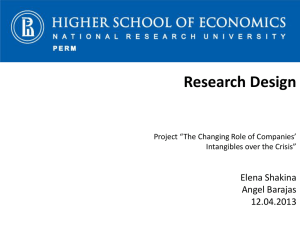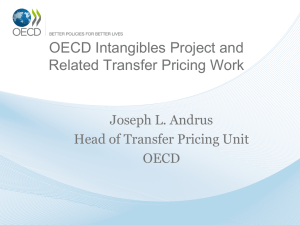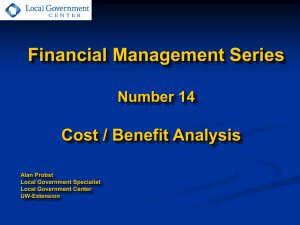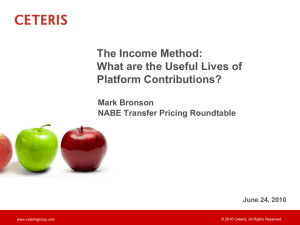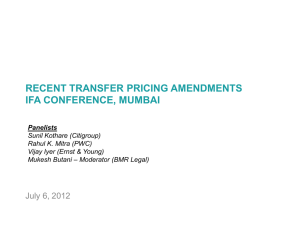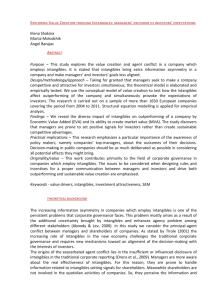Exploring Value Creation through Intangibles: managers` decisions
advertisement
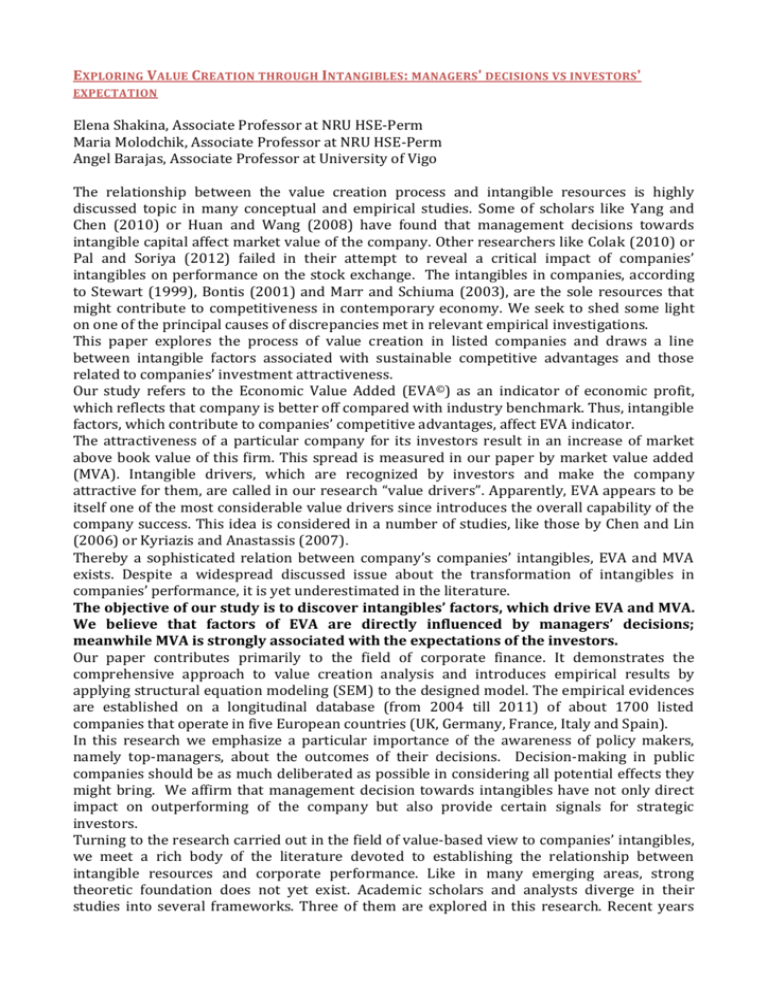
EXPLORING VALUE CREATION THROUGH INTANGIBLES : MANAGERS ' DECISIONS VS INVESTORS ' EXPECTATION Elena Shakina, Associate Professor at NRU HSE-Perm Maria Molodchik, Associate Professor at NRU HSE-Perm Angel Barajas, Associate Professor at University of Vigo The relationship between the value creation process and intangible resources is highly discussed topic in many conceptual and empirical studies. Some of scholars like Yang and Chen (2010) or Huan and Wang (2008) have found that management decisions towards intangible capital affect market value of the company. Other researchers like Colak (2010) or Pal and Soriya (2012) failed in their attempt to reveal a critical impact of companies’ intangibles on performance on the stock exchange. The intangibles in companies, according to Stewart (1999), Bontis (2001) and Marr and Schiuma (2003), are the sole resources that might contribute to competitiveness in contemporary economy. We seek to shed some light on one of the principal causes of discrepancies met in relevant empirical investigations. This paper explores the process of value creation in listed companies and draws a line between intangible factors associated with sustainable competitive advantages and those related to companies’ investment attractiveness. Our study refers to the Economic Value Added (EVA©) as an indicator of economic profit, which reflects that company is better off compared with industry benchmark. Thus, intangible factors, which contribute to companies’ competitive advantages, affect EVA indicator. The attractiveness of a particular company for its investors result in an increase of market above book value of this firm. This spread is measured in our paper by market value added (MVA). Intangible drivers, which are recognized by investors and make the company attractive for them, are called in our research “value drivers”. Apparently, EVA appears to be itself one of the most considerable value drivers since introduces the overall capability of the company success. This idea is considered in a number of studies, like those by Chen and Lin (2006) or Kyriazis and Anastassis (2007). Thereby a sophisticated relation between company’s companies’ intangibles, EVA and MVA exists. Despite a widespread discussed issue about the transformation of intangibles in companies’ performance, it is yet underestimated in the literature. The objective of our study is to discover intangibles’ factors, which drive EVA and MVA. We believe that factors of EVA are directly influenced by managers’ decisions; meanwhile MVA is strongly associated with the expectations of the investors. Our paper contributes primarily to the field of corporate finance. It demonstrates the comprehensive approach to value creation analysis and introduces empirical results by applying structural equation modeling (SEM) to the designed model. The empirical evidences are established on a longitudinal database (from 2004 till 2011) of about 1700 listed companies that operate in five European countries (UK, Germany, France, Italy and Spain). In this research we emphasize a particular importance of the awareness of policy makers, namely top-managers, about the outcomes of their decisions. Decision-making in public companies should be as much deliberated as possible in considering all potential effects they might bring. We affirm that management decision towards intangibles have not only direct impact on outperforming of the company but also provide certain signals for strategic investors. Turning to the research carried out in the field of value-based view to companies’ intangibles, we meet a rich body of the literature devoted to establishing the relationship between intangible resources and corporate performance. Like in many emerging areas, strong theoretic foundation does not yet exist. Academic scholars and analysts diverge in their studies into several frameworks. Three of them are explored in this research. Recent years have seen the developments in the transformation of companies’ intangibles into economic value added (EVA) or market value added (MVA) and q-Tobin’s as well. This kind of research designs are met in the studies by İşeri and Kayakutlu (2007), Nogueira et al (2010), Pal and Soriya (2012). Despite of a clear causality explored in these papers many contradictions still remain. The main discrepancy that has to be studied refers to the distinction of companies’ fundamental and market indicators. In the frame of value-based management, EVA reflects fundamental performance and indicates that a particular company outperforms in the rival environment (Stern, 2001; Zaratiegui, 2002; Gjerde et al., 2010). Market indicators like MVA and q-Tobin’s signify the attractiveness of investment in companies since they introduce the market estimation of the assets over its book value (Stewart III, 1991). If both fundamental and market indicators reflect companies’ performance, they have to provide consistent results in terms of the role of companies’ intangibles. Nevertheless, many studies like those by Tseng and Goo (2005), İşeri et al. (2007) or Pal and Soriya (2012)1 discovered that intangibles influence differently on EVA and MVA. Thus, we hypothesize that this distinction can be explained by specific origins of the factors associate with competitiveness of a particular company and its attractiveness for investors. We trow, that this phenomenon is underestimated in empirical studies by validating the model specification. The second set of papers related to the topic under study addresses the link between economic and market value added. According to the value-based view, MVA can be explained by the ability of the company to create abnormal profit expressed in EVA (Stewart III, 1991). Most of the results in recent studies point out that MVA either has a weak statistical relationship with the EVA generated in the past or even have no relationship with it. This evidence is introduced in papers by Biddle et al. (1999), Fernandez (2002). This phenomenon is likely to be explained by the low predictable power of the historic EVA. It is believed that the shareholders’ awareness about past of a company is not sufficient when deciding to invest. Investors have to be assured in the future growth of a company. The third class of studies challenges the issue of the disclosure of companies’ intangibles. Orens et al. (2009) and Vergauwen et al. (2007) support the idea that a company provides investors with essential and valuable information when voluntarily report about its intangibles. The disclosure likely to be important for establishing transparent relationships between managers and shareholders. Our research attempt addresses a sort of combination of the approaches introduced above by employing the strong points of each of them. Finally, the research framework enables to reveal value drivers of the company linking them with the indicators of competitive performance and investment attractiveness. To be conceived what is the value creation process it might be worthy to look insight the decision making of those who are interested in companies’ value. Corporate value is the key benefit that is brought to companies’ strategic investors. Taking that for granted it is assumed that investors are looking for underestimated shares, which are issued by the high efficient companies. Companies’ top-management meanwhile in trying to attract the capital into a firm has to meet investor requirements and anticipate their expectations. It simultaneously challenges the following: creating its competitive advantages and assuring shareholders and potential investors that the company is likely to succeed. The principal advantage of the framework suggested in our study is related to the selfsufficiency and consistency of the economic profit concept approached to companies intangibles and value-based view to companies’ activity. One of most arguable issues, which have to be challenged when conducting the analysis of intangibles in the company, is the identification of these intangibles resources. According to the analysis carried out in our research five elements of intangibles were validated by 1 İşeri M. et al. Economic Value Added by Intellectual Retailers in a Developing Country / M. İşeri, G. Kayakutlu // Review of Social, Economic & Business Studies/ Volume 3. Number 4. 2007. Р. 83-98. structural equation modeling. As stated there each construct of companies’ intangible resources are described by a number of variables, which separately reflect different features of companies’ intangibles. This approach takes an advantage of employing data generally available in companies’ annual reports, their web sites, information bureaus, rating agencies. By combining these variables in latent intangible constructs we seek to reveal elements, which likely to introduce companies’ value drivers. Following the above-mentioned model we allocate core intangibles of a company into 5 elements: Human Resource Capability (HC) Customer Loyalty and Reputation (CL) Networking Capability (NC) Innovation Capability (InnC) Business Process Capability (BPC) It is important for our research to highlight external conditions, in which companies operate. Accomplishing this purpose we suggest specific intangibles, which not exclusively belong to a particular company, but are generally accessible for every firm in a particular location. Hypotheses of our research are as follows: • Investments associated with Human capital makes a company both competitive and investment attractive • Customer loyalty provides a company with sustainable advantages on markets and is recognized by its investors • Innovative behavior is one of the key value drivers and should be disclosed for investors • Internal processes of a company is highly important for creating its competitive advantages but are not pivot for value creation on the financial market • Networks of a company enable stable growth both on real and financial markets Sig. positive Sig. negative Not sig Figure 1 Relationship of EVA, MVA and intangibles Table 1 Results of structural equation modelling Endogenous variable Market Value Added Economic Value Added Innovation Capabilities Internal Process Capabilities Customer Loyalty Human Resources Stand.coef. Std.Err. 0.172*** 0.035** 0.088*** 0.012 0.018 0.011 0.539*** 0.137*** 0.018 0.028 Capabilities Networking Capabilities 2008 year 2009 year 0.488*** -0.405*** -0.007 0.023 0.010 0.010 -0.080*** 0.025** 0.020 0.015 -0.011 0.097*** 0.020 0.029 -0.120*** 0.018 0.005 -0.059*** 0.028 0.015 0.012 0.012 Economic Value Added Innovation Capabilities Internal Process Capabilities Customer Loyalty Human Resources Capabilities Networking Capabilities Opportunities 2008 year 2009 year Number of observation 5938 RMSEA = 0.087 R-squared = 0.83 Results of our analysis is introdusced in the Table 1 and on the figure 1. Answering the question addressed in our study and testing the hypotheses put forward we would like to emphasize the following: The evidence for the different drivers of MVA and EVA is established on the sample of companies in developed European markets. We specially highlight the positive impact of all intangibles, examined in our study, on market value creation. Nevertheless we have found out the contradictory result in exploring networking capital as a factor of companies’ competitiveness and attractiveness for investors. We have moreover failed to support the hypothesis that client loyalty is a critical factor for companies’ outperforming. The same evidence is associated with the factors of the external opportunities in a firm’s disposal.
